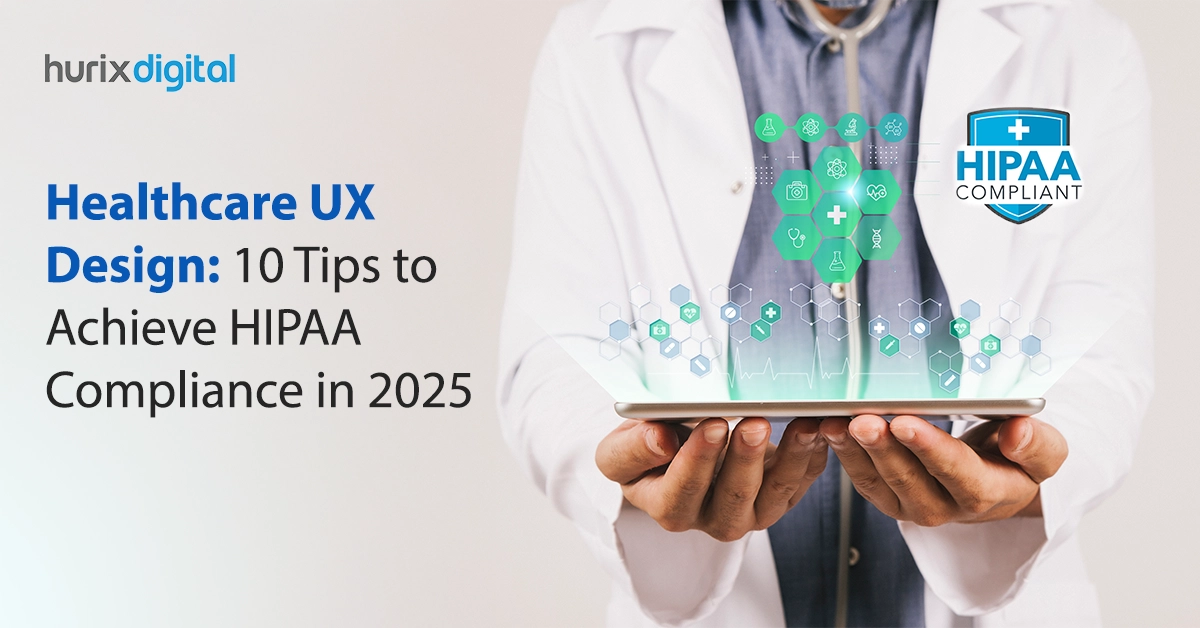
Healthcare UX Design: 10 Tips to Achieve HIPAA Compliance in 2025
Summarize with:
One of the most important parts of making digital tools for businesses, even in healthcare, is designing a good user experience (UX).
The Interaction Design Foundation (IxDF) asserts that user experience design in healthcare can enhance daily life when used appropriately for digital services. This is one of the main causes of the rise in popularity of digital healthcare merchandise in recent years!
Furthermore, it is anticipated that the digital health market will develop at an 8.49% annual pace, attaining a quick growth of US $258.30 billion by 2029.
However, HIPAA Compliance has emerged as a cornerstone of healthcare UX design to ensure a high-end healthcare experience. Let’s explore this in detail!
Table of Contents:
- Overview of HIPAA Compliance
- Benefits of HIPAA Complaint UX Design for Healthcare
- Checklist of HIPAA Compliance for Healthcare UX Design
- Understand the HIPAA Regulations
- Identify and Classify PHI
- Implement Role-Based Access Control (RBAC)
- Use Encryption for Data Transmission and Storage
- Design User Authentication and Authorization Mechanisms
- Create an Intuitive User Interface (UI) for Privacy Notices
- Incorporate Audit Trails and Logging
- Design for Mobile Device Management (MDM)
- Conduct Regular Risk Assessments
- Educate Users on HIPAA Compliance
- Takeaway
Overview of HIPAA Compliance
Health Insurance Portability and Accountability Act (HIPAA), governed by the HHS, was created to safeguard people’s health information. It contains key privacy and security standards for data.
There are five titles in the act itself, and Title II is the one that matters most to IT companies. It mandates that enterprises adhere to stringent privacy requirements established by the HHS and offer safe and secure ways for patients to access their electronic health data.
Benefits of HIPAA Complaint UX Design for Healthcare
Designing UX in healthcare that is compliant with HIPAA safeguards patient information while enhancing usability.
Here is a quick snapshot of the top benefits of HIPAA UX solutions.
1. Enhanced Patient Trust
Patients feel more comfortable disclosing sensitive information when healthcare apps prioritize HIPAA compliance.
Furthermore, patients are encouraged to use digital health platforms without worrying about data breaches when they see a well-designed interface that makes privacy measures evident.
In the healthcare industry, trust is fundamental, and a safe user experience strengthens patients’ faith in their healthcare professionals.
2. Streamlined Workflows
Healthcare professionals’ workflows become more effective if UX design places a strong emphasis on HIPAA compliance.
Additionally, healthcare providers can lessen administrative burdens by creating user-friendly interfaces. This limits the possibility of data entry errors and expedites access to patient information.
3. Regulatory Adherence and Risk Mitigation
Healthcare organizations can avoid expensive fines and legal ramifications by implementing HIPAA-compliant UX design, which helps them stay within the law.
Furthermore, organizations can proactively protect patient data and their reputation in the healthcare industry by incorporating security measures into the design from the beginning.
Also Read: How Can HR Drive Innovation in the Pharma and Healthcare Industry?
Checklist of HIPAA Compliance for Healthcare UX Design
Here is a comprehensive list of steps you must follow to curate a user-focused design that adheres to HIPAA.
1. Understand the HIPAA Regulations
Learn about the Privacy Rule, Security Rule, and Breach Notification Rule—the three main pillars of HIPAA—before you start designing. Knowing these rules makes it easier to determine what Protected Health Information (PHI) is and what protections are required.
- Privacy Rule: Focuses on the protection of personal information.
- Security Rule: Requires administrative, technical, and physical protections.
- The Breach Notification Rule: Lays forth what should be done in the case of a data breach.
2. Identify and Classify PHI
In your UX design, clearly identify what constitutes PHI within your application. You can include any information that can be used to identify a person like:
- Name
- Residence
- Date of birth
- Social Security number
Classify this data appropriately, ensuring that any designs that handle PHI are treated with the utmost level of security.
3. Implement Role-Based Access Control (RBAC)
Make sure that only authorized individuals have access to PHI by designing user roles and permissions.
Role-based access control (RBAC) limits access based on the user’s role within the organization, thereby minimizing exposure to sensitive data.
Pro Tip: Establish roles like healthcare practitioner and patient to ensure each role only has access to the information required for their function.
4. Use Encryption for Data Transmission and Storage
Enact provisions for PHI to render it fully encrypted both in transmission and at rest.
Additionally, apply Secure Sockets Layer (SSL) or Transport Layer Security (TLS) for data in transit and strong encryption algorithms for stored data.
This implication prevents unauthorized access to private data transmissions and retention on servers.
Pro Tip: You may prescribe industry-standard encryption algorithms, such as AES-256, for data in rest and TLS 1.2+ for data in transit.
5. Design User Authentication and Authorization Mechanisms
Incorporate robust authentication mechanisms to verify user identities before granting access to PHI. This may include
- Multi-factor authentication (MFA)
- Strong password policies
- Regular password updates
6. Create an Intuitive User Interface (UI) for Privacy Notices
Create an intuitive user interface (UI) for privacy notices that explains to users how their data will be handled and safeguarded. This information should be simple to find and understand to guarantee that patients are aware of their HIPAA rights.
Pro Tip: Use plain language and accessible formats to explain privacy practices to users.
7. Incorporate Audit Trails and Logging
Ensure that features for recording and auditing PHI access are part of your UX design. This further aids in tracking who accessed what data and when for compliance and the detection of any unauthorized access.
8. Design for Mobile Device Management (MDM)
Ensure your healthcare app conforms with MDM guidelines if it can be accessed on mobile devices.
This entails putting in place technologies that enable data wiping and making sure that data is not kept locally on the device.
9. Conduct Regular Risk Assessments
Include procedures for routine risk assessments in your design process. Also, user feedback loops should be a part of this to find any UX flaws that can leak PHI.
Pro Tip: Design interfaces that allow users to report security concerns easily.
10. Educate Users on HIPAA Compliance
Lastly, include instructional materials in the app to educate users on HIPAA compliance and the value of PHI protection.
In addition to encouraging a culture of compliance, this gives users the ability to actively protect their data.
Also Read: How to Hire the Best Healthcare Instructional Designer for Your Training Needs?
Takeaway
Maintaining an emphasis on patient-centered design and improving interoperability across different health systems are key components of the future healthcare UX design.
There are many interesting developments and formidable obstacles at the nexus of UX design and healthcare. As the field develops, the relevance of UX design in improving the accessibility of healthcare services will only increase.
If you want to build a HIPAA-compliant UX design for your healthcare center, consider Hurix Digital. We provide end-to-end UX consulting services to evaluate and design robust UX.
To explore more about healthcare UX designs and compliance, feel free to get in touch with us.
Summarize with:

Associate Vice President – User Experience Design at Hurix Digital (EMEA), with 10+ years in UX and design leadership. She champions AI‑driven, inclusive, and strategy‑led UX across banking, fintech, EdTech, MedTech, and e‑commerce sectors.
 We’re live! Explore the all-new
We’re live! Explore the all-new 





